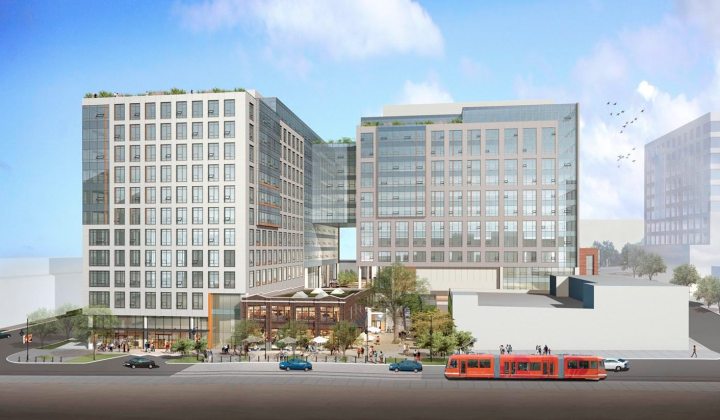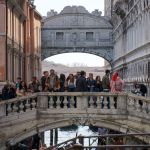Newsdeck
The New Tech Palaces: Visionary HQs, Or Cursed Trophies?

While much of corporate America is retrenching on the real estate front, the four most influential technology companies in America are each planning headquarters that could win a Pritzker Architecture Prize for hubris. By Bill Rigby and Alistair Barr.
Amazon.com last week revealed plans for three verdant bubbles in downtown Seattle, joining Apple’s circular “spaceship,” Facebook’s Frank Gehry-designed open-office complex and a new Googleplex on the list of planned trophy offices.
“It signals a desire, a statement, to say that we’re special, we’re different. We have changed the world and we are going to continue to change it,” said Margaret O’Mara, associate professor of history at the University of Washington, who has written about the building of Silicon Valley.
“It’s also a reflection of robust bank accounts. They have a lot of cash.”
Historically, however, when a company becomes preoccupied with the grandeur of its premises, it often signals a high point in its fortunes. These fantastical buildings may end up as little more than costly monuments to vanity and a loss of focus on the core business that made for success in the first place.
“I’ve been thinking the Apple spaceship is going to get nicknamed the ‘Death Star’ because the project is so big and the timing is so bad,” said hedge fund manager Jeff Matthews of Ram Partners. The building is coming to fruition just as Apple’s product cycles may be maturing, he explained. “It is such a classic contrary indicator that you just get the shakes.” He no longer holds Apple stock.
Walter Price, who runs technology investment funds at RCM Capital Management LLC, shares the outlook: “When companies build big headquarters it’s usually when they’re doing really well and have strong outlooks, and that often coincides with a peak in their stock.” Apple, Amazon, Google and Facebook are battling to recruit tech talent, and attractive campuses help with that, he added, but Apple’s plan has not gone down well with investors. RCM’s tech funds no longer hold shares.
PROJECT RUNAWAY
Amazon’s design, presented to Seattle city planners last week, includes three steel and glass spheres almost 100 feet (30 meters) high, which will serve as the centerpiece for three new skyscrapers that will house a rapidly growing workforce in downtown Seattle.
The plans call for “a series of intersecting spheres with ample space for a wide range of planting material, as well as individuals working alone or in groups.” Amazon declined further comment.
Google Inc, the world’s largest Internet search company, has outgrown its original headquarters in Silicon Valley’s Mountain View and is planning to build a 1.1 million square foot Googleplex nearby.
Called Bay View, it will have nine rectangular buildings, horizontally bent, with living roofs surrounded by courtyards and connected by bridges. No employee will be more than a two-and-a-half-minute walk away from any colleague, a design aimed at encouraging collaboration. A Google spokeswoman declined further comment.
Facebook Inc is taking the collaborative idea a step further, with plans for Facebook West, an addition to its main campus in Menlo Park, California, that will be the size of seven-and-a-half football fields.
Facebook hired Gehry to bring his trademark style of unexpected angles and understated drama to what is essentially one enormous open-plan office, where a worker can wander from one end to the other without ever going through a door. The rooftop serves as a park.
An earlier version of the building plan featured flares on the ends of the structure like butterfly wings, but Facebook decided not to go ahead with them, said Rachel Grossman, associate planner for the city of Menlo Park.
Facebook spokesman Tucker Bounds said the expansion will be “extremely cost-effective” and is needed to help the company develop new products for its users. He declined to comment further.
Apple has the most ambitious idea, a 2.8 million square foot glass ring on 176 acres. It would be in part a monument to former Chief Executive Steve Jobs, who described it as like a spaceship and was closely involved in the plans before he died in 2011.
The project, which could cost up to $5 billion according to reports, would house about 12,000 Apple employees. An Apple spokeswoman declined to comment.
TEMPTING FATE
The technology sector has amassed large cash piles in recent years, leaving many companies over-capitalized, said Bill Smead, head of Smead Capital Management, which oversees $465 million in assets and does not own shares of Apple, Amazon, Facebook or Google. “Over-capitalized companies often don’t perform well, and leaders of over-capitalized companies sometimes squander the money,” he said.
Apple, Amazon and Facebook are not getting tax breaks or other similar financial incentives for their plans, according to local officials. It is not clear if Google is receiving any incentives.
While these plans radiate optimism, they risk bringing down a curse that has befallen big companies just as they construct pyramid-scale palaces.
AOL-Time Warner started building the Time Warner Center, a 2.8 million square foot structure on the edge of New York’s Central Park featuring two towering glass skyscrapers, right as the tech stock bubble popped in 2000, destroying more than three-quarters of the Internet and media company’s value.
The New York Times Co, Wall Street bank Bear Stearns and chemical company Union Carbide also built ambitious headquarters just before their businesses hit tough times.
The “campus curse” has claimed several tech victims as well.
In the early 1990s, Borland Software – once the second-largest independent software company – spent more than $100 million on offices just south of Silicon Valley that featured ponds, tennis courts and a swimming pool. By 2008 the company had been hammered in the market by Microsoft and was worth less than the cost of the complex.
Since then, Yahoo Inc, MySpace, Inktomi, Sun Microsystems and Silicon Graphics have either hatched plans for or moved into swaggering headquarters, only to hit the skids. Google moved into Silicon Graphics’ campus and Facebook took over Sun’s headquarters.
Salesforce.com Inc got the shakes in time. In late 2011 the stock had fallen from a July high, and analysts were criticizing the company for excessive spending on sales and marketing. Earlier approved plans to build a $2 billion high-tech campus in San Francisco were canceled by the following February.
PRODUCTIVITY PREMIUM?
Despite these cautionary tales, some say the new breed of tech companies are smart to construct their own buildings, which match the collaborative way they work and can yield long-term productivity and energy-efficiency benefits.
“As they see energy prices going up they recognize that these buildings have to last longer, and they need to be more in control of the operation costs of these buildings. A property developer does not focus on such long-term things,” said John Barton, director of the architectural design program at Stanford University.
“Employees are more productive in the right kinds of environments. That may be more expensive, but if it pays back in a 5 percent productivity increase, that may be really smart,” he added.
O’Mara at University of Washington suggests the new tech giants are emulating the workplace innovations of the famous Bell Labs, the historic research arm of AT&T that gave birth to the transistor, the laser and technology behind mobile phones over many decades.
Bell’s legendary facility, designed by modernist architect Eero Saarinen in the late 1950s, might not be the right role monument.
Now owned by global telecom giant Alcatel Lucent, the quarter-mile-long mirrored box lies empty, and is likely to end up being turned into a medical center – or razed. DM
Photo: The new Amazon headquarters eventually will have 11 buildings on six blocks along Terry and Boren avenues between Mercer and John streets. There will be 1.7 million square feet of office space and nearly 100,000 square feet of retail. (Via Daily Journal of Commerce)




















 Become an Insider
Become an Insider